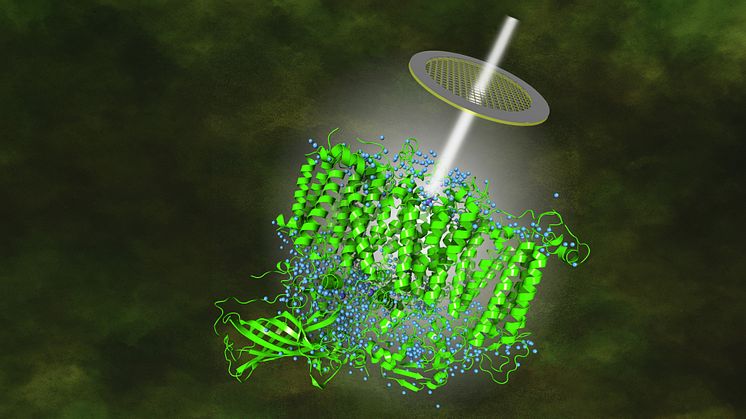
Press release -
Details of photosynthesis revealed with record-breaking images
By generating extremely high-resolution images in a cryo-electron microscope, at a level never achieved before for comparable complexes, researchers at Umeå University have revealed the positions of hydrogen atoms and water molecules in photosynthesis.This breakthrough provides a new avenue towards uncovering how water is split – a process crucial for life on Earth as well as for scaling up renewable energy systems.
In photosynthesis, a protein complex called Photosystem II uses the energy of sunlight to oxidize water into molecular oxygen, releasing electrons and protons necessary for converting carbon dioxide into organic compounds in plants. This process is vital for the gas conversion reactions that shape our biosphere and atmosphere: the evolution of oxygen and the reduction of carbon dioxide.
By utilizing a cryo-electron microscope, researchers have generated a 1.7 Å resolution three-dimensional structural map of Photosystem II from the thermophilic cyanobacterium Thermosynechococcus vestitus. The study is published in the scientific journal Science.
“This resolution is a new record for a membrane protein complex, regardless of method or species. At this resolution a large fraction of the hydrogen atoms of the protein can be detected. This is the first time this has been achieved for such a huge protein complex” says Wolfgang Schröder, professor emeritus at the Department of Plant Physiology at Umeå University.
The high-resolution structure also allowed the identification of water molecules that were missed in previous structures. The knowledge of both hydrogen and water positions are required for understanding how water enters the catalytic site through extended channels and how protons are guided out.
“These processes are crucial for efficient water oxidation with cheap and abundant metals that presently cannot be mimicked adequately in artificial systems,” says Wolfgang Schröder.
Splitting water with cheap metals instead of rare and expensive ones found in present day electrolysers will allow more readily to scale up water electrolysis as a means of producing hydrogen (H2), a much discussed future energy carrier and base chemical for many processes in industry, including CO2-free ammonia production.
Splitting water to make hydrogen is a promising area of research into sustainable fuels. Currently, the most efficient catalysts require rare and expensive metals. This research into the structure of Photosystem II, shows how cheap and abundant metals can be used to efficiently split water, which may provide new insights into energy production in the future.
About the study
Rana Hussein, André Graça, Jack Forsman, A Orkun Aydin, Michael Hall, Julia Gaetcke, Petko Chernev, Petra Wendler, Holger Dobbek, Johannes Messinger, Athina Zouni, Wolfgang Schröder, Cryo-electron microscopy reveals hydrogen positsions and water networks in photosystem II, Science June 21 2024, DOI: 10.1126/science.adn6541
Read the article in Science
https://www.science.org/doi/10.1126/science.adn6541
For more information, please contact:
André Graça, Doctoral student, Department of Chemistry, Umeå University
Email: andre.graca@umu.se
Phone: +46 72 205 68 16
Wolfgang Schröder, professor emeritus, Department of Plant Physiology, Umeå University
Email: wolfgang.schroder@umu.se
Phone: +46 70 589 97 29
Johannes Messinger, professor, Department of Plant Physiology, Umeå University
Email: johannes.messinger@umu.se
Phone: +46 70 167 984 32
Topics
Categories
Umeå University
Umeå University is one of Sweden’s largest institutions of higher education with over 37,000 students and 4,300 faculty and staff. The university is home to a wide range of high-quality education programmes and world-class research in a number of fields. Umeå University was also where the revolutionary gene-editing tool CRISPR-Cas9 was discovered that has been awarded the Nobel Prize in Chemistry.
At Umeå University, distances are short. The university's unified campus encourages academic meetings, an exchange of ideas and interdisciplinary co-operation, and promotes a dynamic and open culture in which students and staff rejoice in the success of others.


